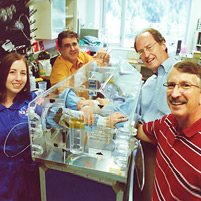Surgery in Space


Surgical care in zero gravity would be a challenge.
And biomedical engineering researchers from Carnegie Mellon University and the University of Louisville are preparing for this possibility.
They are developing surgical tools that could be used on spaceflights to the moon, an asteroid or Mars.
"In deep space, surgical procedures will be severely complicated by absence of gravity, where it becomes difficult to prevent cabin contamination from blood and body fluids," said James Antaki, a professor of biomedical engineering at CMU.
Antaki, CMU researchers James E. Burgess and Jennifer A. Hayden, and George M. Pantalos, a professor of surgery and bioengineering at the University of Louisville, are developing a watertight surgery system to isolate the wound and control bleeding by creating a pressurized aqueous environment within the surgical field.
"We have developed a dome-shaped structure [Aqueous Immersion Surgical System (AISS)] that can be mounted over the surgical area and will prevent contamination of the spacecraft cabin during surgeries that could include working on broken limbs or traumatic injuries," said Hayden, a CMU Ph.D. biomedical engineering student.
The AISS is also designed to reduce or stop bleeding. The system could potentially be used for a wide variety of ground-based surgery.
Prototypes of the astro-surgical system will be tested on four separate flights of NASA's zero-gravity C-9 aircraft from Oct. 2–5 at Johnson Space Center Reduced Gravity Program at Ellington Field, southeast of Houston.
"Flights typically include four sets of 10 parabolic maneuvers. The flight profile determines the level of reduced gravity achieved by simulating the levels of gravity in orbit and interplanetary spaceflight, on the surfaces of the moon and Mars," said Pantalos, who has conducted 27 zero-gravity flight missions for NASA since 1992.
The duration of each period of reduced gravity is between 23 and 30 seconds.
Biomedical engineering research at CMU seeks a fine balance between fundamental engineering principles and clinical applications, and between research methodologies and applications that leverage on those methodologies.
The department adopts a multi-scale structure that takes full advantage of the collaborative culture at CMU to foster a vibrant environment for intellectual exchange.
Photo: From left, Jennifer Hayden, a Ph.D CMU biomedical engineering student; CMU professors James Antaki and James E. Burgess along with George M. Pantalos of the University of Louisville.
Related Links: College of Engineering | The Right Stuff | Google Lunar X Prize | Biomedical Engineering
